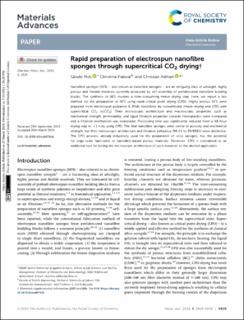Please use this identifier to cite or link to this item:
https://doi.org/10.21256/zhaw-30677| Publication type: | Article in scientific journal |
| Type of review: | Peer review (publication) |
| Title: | Rapid preparation of electrospun nanofibre sponges through supercritical CO2 drying |
| Authors: | Mol, Gioele Fialová, Christina Adlhart, Christian |
| et. al: | No |
| DOI: | 10.1039/D3MA00781B 10.21256/zhaw-30677 |
| Published in: | Materials Advances |
| Volume(Issue): | 5 |
| Issue: | 9 |
| Page(s): | 3929 |
| Pages to: | 3939 |
| Issue Date: | 2024 |
| Publisher / Ed. Institution: | Royal Society of Chemistry |
| ISSN: | 2633-5409 |
| Language: | English |
| Subjects: | Nanofibre aerogel; Critical point drying; Supercritical CO2; Nanofibre sponges; Freeze-drying; Filtration mechanism; Microplastics |
| Subject (DDC): | 660: Chemical engineering |
| Abstract: | Nanofibre sponges (NFS) – also known as nanofibre aerogels – are an intriguing class of ultralight, highly porous and flexible materials currently produced by self-assembly of prefabricated nanofibre building blocks. The synthesis of NFS involves a time-consuming freeze-drying step. Here, we report a fast method for the preparation of NFS using rapid critical point drying (CPD). Highly porous NFS were prepared from electrospun polyamid-6 (PA6) nanofibres by conventional freeze-drying and CPD with supercritical CO2 (scCO2). Their microscopic architecture and macroscopic properties such as mechanical strength, permeability, and liquid filtration properties towards microplastics were compared and a filtration mechanism was elaborated. Processing time was significantly reduced from a 48-hour drying step to < 1 h by using CPD. The final nanofibre sponges were similar in porosity and mechanical strength, but their microscopic architecture and filtration behaviour (99.4 % to 99.998 %) were distinctive. The CPD process, already industrially used for the preparation of silica aerogels, has the potential for large-scale fabrication of nanofibre-based porous materials. Moreover, CPD is considered as an additional tool for tuning the microscopic architecture of such materials to the desired application. |
| URI: | https://digitalcollection.zhaw.ch/handle/11475/30677 |
| Fulltext version: | Published version |
| License (according to publishing contract): | CC BY 3.0: Attribution 3.0 Unported |
| Departement: | Life Sciences and Facility Management |
| Organisational Unit: | Institute of Chemistry and Biotechnology (ICBT) |
| Appears in collections: | Publikationen Life Sciences und Facility Management |
Files in This Item:
| File | Description | Size | Format | |
|---|---|---|---|---|
| 2024_Mol-etal_Rapid-preparation-electrospun-nanofibre-sponges-CO2-drying_MatAdvances.pdf | 3.44 MB | Adobe PDF |  View/Open |
Show full item record
Mol, G., Fialová, C., & Adlhart, C. (2024). Rapid preparation of electrospun nanofibre sponges through supercritical CO2 drying. Materials Advances, 5(9), 3929–3939. https://doi.org/10.1039/D3MA00781B
Mol, G., Fialová, C. and Adlhart, C. (2024) ‘Rapid preparation of electrospun nanofibre sponges through supercritical CO2 drying’, Materials Advances, 5(9), pp. 3929–3939. Available at: https://doi.org/10.1039/D3MA00781B.
G. Mol, C. Fialová, and C. Adlhart, “Rapid preparation of electrospun nanofibre sponges through supercritical CO2 drying,” Materials Advances, vol. 5, no. 9, pp. 3929–3939, 2024, doi: 10.1039/D3MA00781B.
MOL, Gioele, Christina FIALOVÁ und Christian ADLHART, 2024. Rapid preparation of electrospun nanofibre sponges through supercritical CO2 drying. Materials Advances. 2024. Bd. 5, Nr. 9, S. 3929–3939. DOI 10.1039/D3MA00781B
Mol, Gioele, Christina Fialová, and Christian Adlhart. 2024. “Rapid Preparation of Electrospun Nanofibre Sponges through Supercritical CO2 Drying.” Materials Advances 5 (9): 3929–39. https://doi.org/10.1039/D3MA00781B.
Mol, Gioele, et al. “Rapid Preparation of Electrospun Nanofibre Sponges through Supercritical CO2 Drying.” Materials Advances, vol. 5, no. 9, 2024, pp. 3929–39, https://doi.org/10.1039/D3MA00781B.
Items in DSpace are protected by copyright, with all rights reserved, unless otherwise indicated.